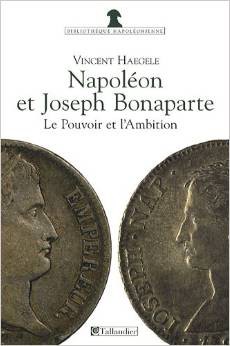History Prizes 2010
 FIRST EMPIRE PRIZE
FIRST EMPIRE PRIZE
Vincent HAEGELE, Napoléon et Joseph Bonaparte, le pouvoir et l’ambition, Paris, Tallandier
A conflicting character, unfulfilled in his military career, and frequently misunderstood, the image of Joseph Bonaparte often pales in comparison with the legend that surrounds his younger brother, Napoleon. Nicknamed the “casual king” and portrayed as lazy, the “meilleur des frères” comes across as a weak individual who accepted the crowns “snatched away from two legitimate foreign families”. However, the French emperor’s elder brother was to prove a pillar of the new regime introduced after the 18 Brumaire coup d’état. Appointed king of Naples (and subsequently Spain), Joseph strove – fruitlessly it would prove – to combine the principle of familial solidarity with his own ideas regarding power. Unable to handle the fermenting tensions between him and the master of Europe, he transformed gradually into a determined opponent. It is this complex and, at times, violent relationship shared by the king and the emperor that this work explores. Using personal archives and a rich reserve of correspondence, Vincent Haegele investigates their upbringing, their development during the Revolution, the Neapolitan experiment and the Spanish failure, as well as the dark days of the French campaign. Analysing the ties that bound Joseph and Napoleon Bonaparte, this work is a fascinating history of two brothers whose lives were intimately intertwined with France’s fate at the turn of the 19th century.
 SECOND EMPIRE PRIZE
SECOND EMPIRE PRIZE
Gabriel BADEA-PAÜN, Le style Second Empire, Paris Éditions Citadelles et Mazenod
Visiting the Opera House during its construction phase, the French empress Eugenie took it upon herself to interrogate Charles Garnier on the historical inspiration behind the building’s décor: “But what is the style? It’s not classical, it’s not mediaeval, it’s not Renaissance.” “It is Second Empire, Ma’am,” replied the architect. The rest of this dialogue – whether real or imagined – is not reported but we can be reasonably certain that it would have given the sovereign much food for thought. This new aesthetic – governed by the principle of eclecticism – was to constitute a individual style all of its own, one of complexity, subtlety and incredible creativity. Not only did it take its inspiration from all that had gone before – prioritising no single historical movement in particular – but it succeeded in renewing it at the same time. An artistic and decorative historicism, the style embraced various different stylistic references, combining multiple sources – both historical (ranging from the Renaissance to the end of the 18th century) and geographical (most notably oriental) -, techniques and materials to produce an often troubling polyphony. And within this eclecticism of Second Empire style stood the recurring principle of comfort and not a little solemnity. This highly original book throws open to its readers the doors of the palace salons and private townhouses – including the Palais des Tuileries, the châteaux at Compiègne, Saint-Cloud and Pierrefonds, the Rothschild family’s château at Ferrière, and Waddesdon Manor – which contributed to the splendor of the Second Empire and its international reputation. The work explores the birth and development of a new “art de vivre” which provided the spiritual basis for modern-day residences.
 PRIZE FOR A BOOK IN A LANGUAGE OTHER THAN FRENCH
PRIZE FOR A BOOK IN A LANGUAGE OTHER THAN FRENCH
Dominic LIEVEN, Russia against Napoleon. The True Story of the Campaigns of War and Peace, Ed. Penguin Books
This book by Dominic Lieven, Professor of Russian Government at the London School of Economics, is an exceedingly welcome addition to the long list of books on the French campaign in Russia in 1812 and the aftermath covering the following two years. The title correctly spreads the contents of the book from Tilsit to the first abdication in 1814. And Lieven is right to underline that it is almost a nonsense to study only 1812 since the conflict (and Russia’s final victory) did not come at the Berezina. The contention that the book looks at the struggle from the Russian point of view is also important. The wealth of French memoirs on the subject and 19th- and 20th-century obsessions with Napoleon have indeed led to imbalance. Lieven’s book is thus more than useful. In addition to being engagingly written, it is also particularly convincing in its use of Russian military history sources (battalion histories, personal memoirs) and its concentration of perhaps Russia’s greatest (and least-known) victory over the problems of supply and logistics. Some of Lieven’s most interesting pages reveal the massive Russian effort and skill brought to bear on the problems related to moving men and food, and providing huge quantities horses and military hardware across vast distances in an age before steam. Another of Lieven’s important emphases is on the quality of Russian army (not just of the almost legendary stoic, “stand-and-be-killed” variety) and its ability to perform cavalry reconnaissance (in the face of traditional poor French performance in this respect) and to perform text-book strategic retreats. Hard-bitten military enthusiasts are treated to appendices containing the orders of battle in 1812 and 1813, whilst historians in general can dig their teeth into the detailed bibliography and the long list of further reading. We follow the Economist. This is indeed a “landmark book”.
